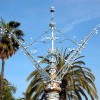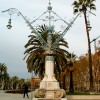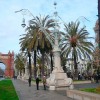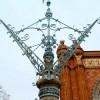Lampposts of the Passeig de Lluís Companys
Passeig de Lluís Companys
Architect: Pedro Falquès
Material: Forged iron
This set of streetlights that we are on the axis linking the Arc de Triomphe with Ciutadella Park are part of the request made by the City of Barcelona 1905 the architect Pedro Falqués and Urpí next to Paseo de Gracia and the old Cinco de Oros, at the intersection of that with Diagonal avenue.
In the old Hall of San Juan we find what looks like a compromise between the two samples mentioned lampposts, combining both solutions and adapting them to the place and function of the Paseo.
It is eleven lamps that combine infrastructure stone and iron on top. As in the lampposts on Paseo de Gracia and other street furniture that Falqués designed (the source-lamp Canaletas or draft Public source for street Cucurulla), the function of illuminating unites sit, placing on the part bottom four banks separated by four robust volutes that support the rest of the column. The iron piece begins about what would be its capital, in inverted onion, and continues bifurcating into two symmetrical parts: two diagonal arms (which could remind the arms of port cranes and differentiating the Paseo de Gracia, where one arm stands above the second, much shorter) joined by a central axis decorated with vegetal forms of sinuous lines that print lightness to the work.
Joins two very different styles and languages like classicism (and goticismo) that dominates the Axis Gaudí lampposts, eliminating the feeling of heavy and sturdy piece as in this case; with the modernism of the lampposts on Paseo de Gracia, much lighter to preponderate over the wrought iron stone (which is also covered with pieces of white ceramic tile).
The two lamps to light the emerging central axis of Lluís Companys promenade but also help mark the side roads. The ride thus becomes Great Hall to stroll, relax and enjoy the outdoors. The fact that from 1841 Barcelona adopted the use of gas, allowed to experiment with new forms of lighting and lampposts became not only elements of transformation of life on the street (nightlife, increased security ... ) but also essential to the design and align the streets and become part of the urban complex components.
-
S. Pere, S. Caterina i La Ribera - Pg. de Lluís Companys
-
Metro
L1 ARC DE TRIOMF









